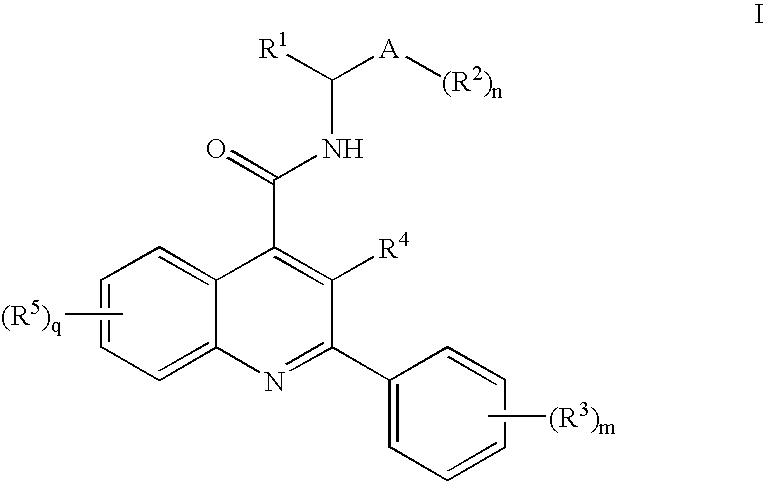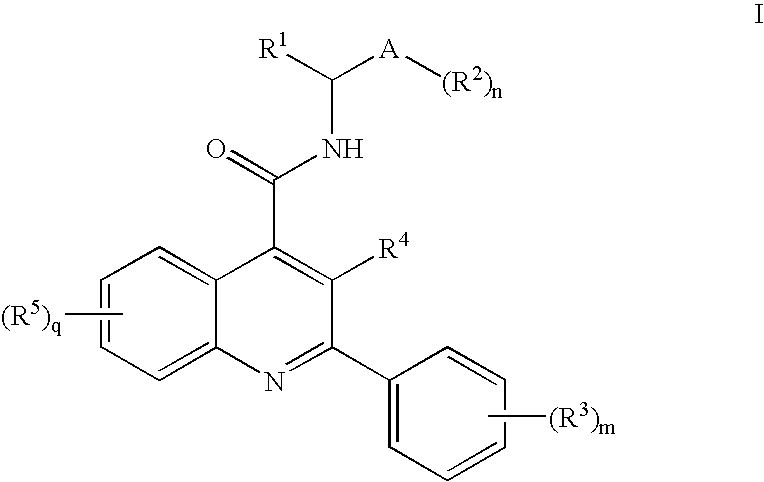N-Oxo-Heterocycle and N-Oxo-Alkyl Quinoline-4-Carboxamides as Nk-3 Receptor Ligands
a technology of noxoheterocycle and noxoalkyl quinoline, which is applied in the field of quinoline derivatives, can solve the problem of limiting the potential to evaluate these compounds in many appropriate disease models
- Summary
- Abstract
- Description
- Claims
- Application Information
AI Technical Summary
Benefits of technology
Problems solved by technology
Method used
Image
Examples
example 1
3-[(dimethylnitroyl)methyl]-2-phenyl-n-[(1S)-1-phenylpropyl]quinoline-4-carboxamide (1)
[0145]
[0146]To a stirring solution of 3-[(dimethylamino)methyl]-2-phenyl-N-[(1S)-1-phenylpropyl]quinoline-4-carboxamide (90 mg, 0.21 mmol) in CH2Cl2 (2 mL) at −10° C. was added MCPBA (53 mg, 70-75%, 0.23 mmol). The reaction was allowed to stir 5 min., the cooling bath removed, then stirred another 0.5 h. Sodium thiosulfate (1.1 eq.) was added along with H2O (1 mL) and aqueous 1 N NaOH (1 mL). The suspension was stirred vigorously for 2 min., layers separated, the organics dried over Na2SO4, filtered, and concentrated under reduced pressure. The residue was purified by silica gel chromatography (0-9% MeOH / EtOAc) to give the desired product as a foam solid. 1H NMR (300 MHz, CDCl3) δ 8.23-8.04 (m, 2H), 7.81-7.27 (m, 13H), 5.44-4.21 (m, 3H), 3.32-2.30 (m, 6H), 2.17-1.91 (m, 2H), 1.13-0.98 (m, 3H); LCMS: m / z 440 (MH+); HRMS m / z 440.2308, calcd. 440.2338.
example 2
3-[(1-oxidopyrrolidin-1-yl)methyl]-2-phenyl-N-[(1S)-1-phenylpropyl]quinoline-4-carboxamide (2)
[0147]
[0148]To a stirring solution of pyrrolidine (14 mg, 0.20 mmol) in CH2Cl2 (1.5 mL) was added 3-(bromomethyl)-2-phenyl-N-[(1S)-1-phenylpropyl]quinoline-4-carboxamide (60 mg, 0.13 mmol), then DIPEA (0.026 mL, 0.14 mmol). The reaction was allowed to stir for 1 h. at which time an LCMS sample was taken which indicated that coupling had occurred. [LCMS: m / z 450 (MH+).] It was then cooled to 0° C., MCPBA (70-75%, 51 mg, 0.22 mmol) added, the cooling bath removed and reaction stirred 10 min. Additional MCPBA (30 mg) was added, reaction stirred for 20 min., then heated at 40° C. for 0.5 h. Again additional MCPBA (30 mg) was added and reaction heated at 40° C. for 0.5 h. Additional MCPBA (30 mg) was added and reaction again heated at 40° C. for 0.5 h. It was then allowed to cool, 5 equivalents of sodium thiosulfate added, then H2O (1 mL) and suspension stirred until solids had dissolved. Aqueou...
PUM
 Login to View More
Login to View More Abstract
Description
Claims
Application Information
 Login to View More
Login to View More - R&D
- Intellectual Property
- Life Sciences
- Materials
- Tech Scout
- Unparalleled Data Quality
- Higher Quality Content
- 60% Fewer Hallucinations
Browse by: Latest US Patents, China's latest patents, Technical Efficacy Thesaurus, Application Domain, Technology Topic, Popular Technical Reports.
© 2025 PatSnap. All rights reserved.Legal|Privacy policy|Modern Slavery Act Transparency Statement|Sitemap|About US| Contact US: help@patsnap.com



